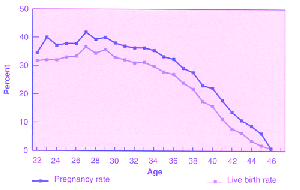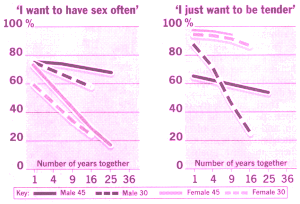Sexual Intercourse
This
article focuses on the sex life of transsexual women who have
had Sex Reassignment Surgery (SRS) - a separate article is
really needed for pre-SRS women. Whilst male to female
transsexuals have widely differing sexual experiences, I believe
that this comment from Nikkey - two years after she had SRS at
age 25 - fairly represents the majority: "I enjoy sex like any
normal girl".

After her
SRS Nicole had a
very active sex life as a woman. But she was
shocked when a close male relative wanted to
have sexual intercourse with her. |
By definition, male to female Gender/Sex Reassignment Surgery
radically alters the primary and secondary sexual genitalia of
the person who undergoes this. Whatever their
sexual inclination, most post-SRS
transwomen have a great curiosity about having sexual
intercourse (coitus) with a man as a woman. A quote from a
British transgender woman:
I had sex change surgery which,
according to the letter I received from my doctors ... produced
'an excellent result'. I was quite relieved to learn that,
as I did not know for 2 months after the op whether or not I was
a surgical success or failure. Mind you, I secretly
started having vaginal sex way before I was allowed to do it, so
by the time I got the official licence to shag, I was far from
being a virgin LOL!
"Just make sure you tell them all
to be gentle with you the first few times" said my surgeon.
Little did he know!
I'm now fully recovered & have to tell you: vaginal sex is
absolutely wonderful, I can completely lose myself in a guy's
arms as it makes me feel like the ultimate REAL DOLL I have
always wanted to be.
The above quotation certainly doesn't apply to all transsexual
women, but most can relate to most of it.
Physiology

Kelly van der Veer
had SRS age 19 and has a functional neo-vagina. She
has appeared in several Dutch TV reality shows - often
appearing topless or nude. They even showed her enjoying
sex on the beach with a co-star. |
Obviously, a pre-requisite for having sexual intercourse (coitus) with a man as a woman is the
possession of a vagina, or rather a neo-vagina
in the case of
transwomen. However, not all natal vagina's are equal in
their appearance, size, depth, smell, lubrication, feel and
sexual stimulation. This is far more the case for the
neo-vagina of transwoman.
Whilst the use of an expensive but highly rated surgeon and clinic can maximise the odds of
the successful creation of a neo-vagina, there is always some risk of complications. Most
post-SRS/GCS women end-up having at least one follow-on surgical
procedure on their bottom genitalia. This may be only to improve
the visual appearance of the vulva, but all too often its needed
to try to fix serious problems such as poor healing, constant
pain due to nerve damage, excessive bleeding, damage to the
urinary tract, lack of depth and frequent infections.
Sexual intercourse is thus the last thing that some post-GCS
women want or need until their physical problems are resolved.

Being 'swept off my feet' by a man is the dream of many
women, but for most transwomen allowing a relationship with
a heterosexual man to develop into physical intimacy and
sexual intercourse is immensely stressful and worrying. |
A Rain Check
For many post-GCS women, their first sexual experiences after
surgery will strongly influence their future sexuality.
However, transwomen have radically different physical and
mental experiences when they have intercourse after GCS. For example, one transwoman
in her late 20's said after her
first night with a man after GCS, "I had discovered sex ... a new hobby
... more boys into bed!".
But for others the experience can be a huge disappointment, one
transwoman in her early 40's says of her first experience after
GCS with a
man: "Just worried [beforehand] ... [then] I was bored ...
[now] have
to change the sheets".
Another now married transwoman admits "I don't have the
sex drive I had as a boy ... my husband wants sex all the time
but I limit it to maybe every other night as it's so boring."

Jennifer
transitioned at 21 and had SRS age
30. Shown age 39. |

Billie Lee had SRS age 25, but it was another 18 months before
she first had vaginal sex as woman, which she found to
be uncomfortable. |
Even worse, some post-GCS women find that the penetration of
their neo-vagina by a penis to be painful, and that all too
often intercourse leads to yeast infections and UTIs. Yeast infections cause itching, pain and vaginal discharge. UTIs
cause urinary problems such as a frequent urge to urinate and
painful urination.
Perhaps inevitably there seems to be a degree of correlation
between sexual satisfaction and successful physical
feminisation, including age of transition and high-quality
surgery. Good physical feminisation results in more
relationships with attractive and 'sexy' partners, and hopefully
more enjoyable physical sensations during everything from
kissing, petting and nipple sucking, to clitoris stimulation and
vaginal penetration.
Individual priorities also vary dramatically, as
the requests made of surgeons in relation to constructing or
enhancing the female secondary sexual characteristics of
transsexual women show. By a large margin the first
surgery sought by transsexual women is actually breast
augmentation, not SRS.
Facial feminisation surgery is often the next priority.
Prior to about 1995 this really meant just a nose job (rhinoplasty),
but progress since then has been extraordinary. For many
transwomen with deep pockets and willing to stand the pain, an
attractive female face is often only a few large cheques away.

This painting by Ford
Madox Brown is unusual as it depicts Romeo with a mature
Juliette.
|
Sex reassignment surgery is
often the last item on the surgery
list. Whilst a small number of usually very young transwomen
prioritise this before anything else, the sheer cost (both
financially and in time) of the procedure results in it having
to be deferred. Instead a priority is given to
hormone treatment and cheaper surgical procedures
with
visible returns such as orchiectomy, breast
augmentation, facial feminisation, tracheal shave and voice
feminisation.
For older women there seems to be a divergence between stated
intentions when first seeking surgery, and the reality when
speaking to the surgeon just before having the procedure.
At "crunch
time" they often a prioritise a natural looking vulva area
and
sensitive clitoris suited to masturbation and lesbian
relationships, over a deep vagina suited to coitus and
penile penetration. How much this last-minute openness
actually affects the imminent surgical procedure is a moot
point.
A 2017
paper by
Sanne W. C. Nikkelen and collaborators in the Netherlands
described the results of a survey of the sexual experiences of
576 Dutch transgender adults (age 17-67). 67 of
these had completed male-to-female gender-confirming treatment (GCT; i.e., hormonal treatment and
genital surgery). The extracted results for just these 67 are interesting:
|
Measure |
Score |
Notes |
|
Lifetime experience of sex (% yes) |
88% |
|
|
Sexually active in past 6 months (% yes) |
45% |
|
|
Masturbates (% yes) |
82% |
|
|
Sexual agency, Average (Standard Deviation) |
3.98 (0.71) |
1 |
|
Sexual pleasure, Average (SD) |
3.60 (0.79) |
2 |
|
Sexual esteem, Average (SD) |
3.34 (0.86) |
2 |
|
Frequency of sex, Average (SD) |
0.78 (0.98) |
3 |
|
Frequency of masturbation, Average (SD) |
1.48 (1.02) |
3 |
|
Sexual satisfaction (percentage) |
|
|
|
Satisfied |
35% |
|
|
Not satisfied, not
dissatisfied |
33% |
|
|
Dissatisfied |
33% |
|
|
Importance of sex (percentage) |
|
|
|
Important/very
important |
46% |
|
|
Not important, not
unimportant |
28% |
|
|
Unimportant/very
unimportant |
25% |
|
Notes:
-
A measure of whether having sex was a conscious, empowered
and consenting decision (5), to an enforced and non-consenting rape (0).
-
Scores ranged from 0 to 5, with higher scores indicating higher pleasure
and self-esteem.
-
Scores ranged from 0 (never) to 3 (more than once a week).
It is notable that less than half of the surveyed women
were sexually active and considered sex to be important, and only a third were satisfied
when they did have sex. However, the study also found a direct correlation between age
(almost linear) and
the frequency of sex,
frequency of masturbation, sexual satisfaction and the importance of sex.
An even more important factor was whether the woman was in a relationship. The
unsurprising conclusion is that a young transwoman in a
relationship is far more likely to be sexually active and
sexually satisfied than a mature transwoman not in a relationship.


Chelsey and male friend

Lauren - probably a staged press photo |
Sexual Activity
Regardless of increasing gender diversity in the 21st century,
there is no doubt that the vast majority of young
(under 30) transwomen have a strongly female
heterosexual orientation and libido - before and after surgery.
An intense desire to have intercourse (aka be fucked) as a woman by a man is commonplace.
One young transgirl
describes her SRS at 18 and early sexual experiences as follows:
"I didn't
need the operation to feel like a girl because I already felt
like one. I had the operation so I could have sex like other
women. ... So I could have more [vaginal depth and]
orgasms I paid [an] extra £1,000. I was in hospital for
three weeks and two weeks after I came out, I was ready for a
test run. I went to a disco with the sole intention of picking
up a man for sex. I looked for one who was trendy and
attractive. I didn't want a virgin or someone who'd be glad of
anything he could get! When I'd found the perfect
guy, he took me home and wanted to light candles but I made him
do it with all the lights on. I had to make sure that it
not only felt OK but looked OK. I have a faint scar on my
tummy and I've been told it would take a gynaecologist to tell
the difference, but I had to find out. Afterwards, he
asked for my phone number but I gave him a false one because he
was just an experiment. I had a few more experiments after
that and remember being complimented on my wonderful muscle
control."
Many young girls make up for lost time after their
surgery. For example:
-
Caroline Cossey
(who famously modelled as 'Tula') admits that after her SRS at age 21, she
"went a little wild ... I felt I needed to experiment
and experience a number of relationships. None of the
men I slept with had any idea of my past".
-
'A'
had SRS at age 17, she claims that over the next four years
she had sex with "... at least 500 men. I'm just a
woman with needs and all these men have satisfied my sexual
desires".
-
'C'
admits that "About three months after my surgery I went to a
swingers’ party and had sex with ten different men."
-
'M'
had SRS at age 21. She then had sexual relationships
with over forty different men in less than a year before
"settling down" with just three boyfriends - two of whom
were married.
-
Chelsey had SRS when age 22 and admits to being "man mad ...
I cater for men!"
-
'J'
had SRS at age 25, three year later she said "I must have
slept with about thousands of men [sic] ... I do it most nights"

A social media picture posted by Deana O'Riordan, born Dean
|
-
When the boyfriend of 'T' learnt that she had had SRS at 19, his
only comment was about her insatiable demand for sex. She
admitted "I want sex [with men] all the time - you could say
I'm a bit of a sex maniac."
-
'A' had SRS in her early 20's. Her hobbies are now “horses, sex and men”
-
After 'L' had SRS age 18, she organised a contest - the winner being the first man to have sex with her as a woman, the only condition being that he wore a condom. She thinks of sex “about every 90 seconds”!
-
A minor British celebrity Lauren Harries had SRS in 2001, age 21. The media extensively reported her subsequent very active sex life, most notably with “B” list celebratory Russell Brand.
-
Deana
transitioned age 6 but didn't have gender confirmation surgery
until age 21, when she was a student. After years of
sexual frustration she was able play the field and enjoy life with one-night stands, saying "I'm just having fun like a normal girl in her 20's”.
These women are all passable and had SRS
by their twenties.
Unfortunately, many older post-SRS transsexual women who
desperately desire and seek sex with men as a woman find that
their mature age and poor passability means that such
occurrences are rare - and associated depression and
disillusionment is not unusual. However. there are a few
exceptions:
-
40-something
Anne spent the first anniversary of her SRS on holiday in
Ibiza, "getting f**ked by as many young men as possible"
-
 Anabelle transitioned age 24 but
didn't have SRS until 41.
"I [then]wanted to give casual dating a go". She
started used dating apps with great success, but admits
'The more fun I have, the more I seem to be voluntarily asking myself "Is this okay?" Anabelle transitioned age 24 but
didn't have SRS until 41.
"I [then]wanted to give casual dating a go". She
started used dating apps with great success, but admits
'The more fun I have, the more I seem to be voluntarily asking myself "Is this okay?"
-
Crystal Warren (right) confessed on a British TV talk-show to
having a sex addition and claimed to have slept with more than a
thousand men - "I was sleeping with up to seven men a day and
even now I can’t go more than 24 hours without sex". The
next day the Sun newspaper revealed that 42 year-old
Crystal
had been born Christopher and had a
sex-change operation age 35.
 But there are also many transwomen who consider themselves as to
be heterosexual, but in practice have little interest in actual
sexual intercourse. For example, Samantha Kane had
SRS at age 37, whilst this was aesthetically very successful she concluded after
intimacy with five boyfriends that having sex as a
woman was rather boring - and far less interesting than a shopping trip. But there are also many transwomen who consider themselves as to
be heterosexual, but in practice have little interest in actual
sexual intercourse. For example, Samantha Kane had
SRS at age 37, whilst this was aesthetically very successful she concluded after
intimacy with five boyfriends that having sex as a
woman was rather boring - and far less interesting than a shopping trip.
Also, things can take a devastating turn for the worse.
Angel (right), who had SRS age 17, discovered a year later that her
apparently devoted 38-year-old boyfriend was also sleeping with
her still married mother. When challenged, her mother
brutally said "once you became a woman you became a threat", and
that men preferred "a real pussy".

Fabiola Nogueira (top) was a shemale porn star
in Brazil.
She spent the money she made on feminisation surgery and
eventually SRS. She then disappeared
for several years before being outed as Ella, a high-class female escort
working in Italy. |
The Lure of Money
The sexual image of transsexual women has been
distorted by the prevalence of pre-SRS 'shemales' working as
prostitutes, with a functional penis.
Many transgender women
claim that the only way they could fund the high cost their
sex-reassignment/gender confirmation surgery was by working as
she-male prostitute.
This has become a
huge world-wide industry, and very lucrative for the girls and
minders involved. Even excluding Asian and South American
girls, empirical evidence indicates that a third to a half of
all young pre-operative transsexuals have accepted money for
sex. Large numbers of transwomen are being embarrassed
when unexpectedly faced with photos and other evidence taken
from porn sites years earlier.
Whilst trying to ignore the controversy about
Professor Bailey's idea's, it does
seem that there are two categories of girls involved -
those that never eventually have SRS, and those that do.
For the later, prostitution is often an unfortunate but
quick way to save the money needed for surgery, e.g.
Cristini Notta said, "My penis paid for my vagina".
Some lucky shemales (generally in their teens or
early twenties) may find "sugar daddies" who are willing to
support them financially and even pay for medical treatment and
surgery. The latter is usually for breast augmentation
but may extend to SRS/GRS - which can be very difficult to
refuse even if they have serious doubts.
Sadly, many shemale
prostitutes who have radical 'bottom surgery' to their male
genitalia soon regret this.
 A slightly different approach is the
financial opportunities offered by online
websites that require a subscription to
access content, usually of a "soft porn" nature.
Attractive transwomen with a social media presence find that they are bombarded with requests for everything from nude
photos to partnering a man on a luxury holiday - often accompanied
by the offer of substantial sums of money. For example,
Daria Jane (right), a post-GCS woman from Romania,
rejected the intimate offers she was being made but became
increasingly annoyed that websites were selling photos of
her (including fake nudes) without her permission.
Finally, she set-up an
OnlyFans account
which features sexy and topless photos of her (although nothing
more than used to featured in daily UK newspapers until about
2015), cams and streaming videos, and interactive online events. A slightly different approach is the
financial opportunities offered by online
websites that require a subscription to
access content, usually of a "soft porn" nature.
Attractive transwomen with a social media presence find that they are bombarded with requests for everything from nude
photos to partnering a man on a luxury holiday - often accompanied
by the offer of substantial sums of money. For example,
Daria Jane (right), a post-GCS woman from Romania,
rejected the intimate offers she was being made but became
increasingly annoyed that websites were selling photos of
her (including fake nudes) without her permission.
Finally, she set-up an
OnlyFans account
which features sexy and topless photos of her (although nothing
more than used to featured in daily UK newspapers until about
2015), cams and streaming videos, and interactive online events.
Many transwomen have
become OnlyFans content creators, and some claim to
make "six figure sums" a year via
paid subscriptions (typically $5-10 a month).

 However, the reality is that only 5% of
OnlyFans creators average annual earnings of more than $300
a month. In order to make more
than that it is necessary to be a standout, have
constant self-promotion (e.g. on boards) and make
creating new content a
full-time job. There are also considerable outgoings
- everything from constantly buying new clothes to paying for
professional photo shoots. Nevertheless,
top pre-GCS shemale porn stars such
as Natalie Mars, Daisy Taylor and Aubrey Kat probably earn about
$1 million a year. However, the reality is that only 5% of
OnlyFans creators average annual earnings of more than $300
a month. In order to make more
than that it is necessary to be a standout, have
constant self-promotion (e.g. on boards) and make
creating new content a
full-time job. There are also considerable outgoings
- everything from constantly buying new clothes to paying for
professional photo shoots. Nevertheless,
top pre-GCS shemale porn stars such
as Natalie Mars, Daisy Taylor and Aubrey Kat probably earn about
$1 million a year.
A handful of exceptional post-GCS trans escorts
such as Giuliana Farfalla and Thalita Zampirolli that are
sought after by ultra-rich men can charge up to $10,000 a day,
and make over $2 million
a year in cash and gifts.
|

In
February 2022 transwoman Rose Montoya posted this photo, with the
caption "This is my gender euphoria". |
Gender Euphoria
In recent years the concept of Gender Euphoria
has emerged, this means being
very satisfied, even elated, that your physical appearance and
a lifestyle now matches your mental gender. It is effectively the
opposite of Gender Identity Dysphoria (GID) - where there is extreme
dissatisfaction which leads to transition, hormones and radical surgery.
Some transgender women experience
sexual excitement and even orgasms just from seeing their feminised
body, breasts and
neo-vagina. A key component mentally is the ability (even if
never practiced) to have vaginal sexual intercourse as a woman
after MTF gender confirmation surgery.
Going Mental
Erotic fantasies are a normal and healthy fact of life for
women and transwomen, a few are even able to bring
themselves to orgasm though imagination alone, without any
physical stimulation - something very rare in men.
According to Dr Alfred Kinsey, 2% of women can reach orgasm
just from fantasising, with no physical stimulation!

Cara is a post-SRS transwoman who claims to reach orgasm about 15 times a week
with the help of her female sex toys. No men
required! |
Many women have private fantasies involving sadomasochism,
sexual harassment, assault and rape, which they use as
stimulation during masturbation. The use
of female sex toys to supplement these mental fantasies with physical
stimulus greatly increasing the chances of reaching orgasm.
During foreplay and love making with a partner, women are
more likely than men to imagine that they are making love to
an out-of-reach object of desire (film star, pop star, etc.)
Compared to cis-women, transwomen have a few additional
quirks:
For a substantial proportion of heterosexual transwomen, the
physical act of vaginal penetration
by a man as a woman causes extreme mental excitement which leads to
an orgasm, i.e. very little actual physical stimulation
is required.
On the other
side, for a lesbian transwoman a mass orgy with the Chippendales
studs is just a waste of lubricant, whilst just holding hands with a
XX girlfriend in public is sexually exciting.
Mental Confusion
Gender confirmation surgery self-evidently
involves the physical reconstruction of male genitalia to appear
as female genitalia. In the best cases only an internal
medical examination can differentiate between the genitalia of a
transwoman and a cis-woman. However the nerves and
mind may not align with this for many years. Emma had GCS
age 24 and considers herself a heterosexual woman, but still
finds:
"Sometimes even now in my
sexual experiences, I want the person so bad that I have this
urge to penetrate them and come inside of them like I did when I
was a man. It happens with feminine guys who don't want to be
masculine or take charge, so I want to be in the masculine role.
With more masculine guys, it's the opposite."
|
The Sexual Cycle in a post-SRS Transsexual Woman.
Excitement:
As the woman
becomes aroused, blood starts to accumulate in the pelvic area.
Vaginal lubrication begins - this will generally be closer to
genetic female norms the longer since surgery. (The
presence of lubrication does not necessarily mean that a woman
is ready for intercourse. And it's certainly no indication
of being close to an orgasm! Penetration is much more
pleasurable if other forms of stimulation are continued for a
while longer.)
As sexual
stimulation continues, the outer lips, inner lips, and sometimes
the breasts begin to look swollen or enlarged.
The clitoris also enlarges - to an embarrassing degree in a few
transwomen (this is very difficult for surgeons to get right).
Plateau:
During this phase, the vaginal lips become even puffier. The
tissues of the walls of the neovagina swell with blood and the
opening to the vagina narrows. Breathing and pulse rate
quicken. A "sex flush" may appear on the stomach, breasts,
shoulders, neck, or face. The areolas of the nipples may
swell, even on small breasts. Many of the woman's muscles
- thighs, hips, hands, and buttocks - may tighten.
Orgasm: The woman's breathing, pulse
rate, and blood pressure continue to rise. The mounting
muscular tension and engorgement of blood vessels reaches a
peak. Orgasm occurs. Sometimes the orgasm comes with a reflex
grasping-type muscular response of the hands and feet.
Some women feel a warmth emanating from their genital area.
Since orgasm is most often triggered by clitoral stimulation or
deep penile penetrations (dependent upon the individual and the
surgical technique used for her SRS), the excitement usually
stops if the stimulation stops. An incomplete release can
be very frustrating! Consistent and continuous
stimulation in the particular way each woman wants it is usually
required to bring a woman to orgasm.
Resolution: This is when the genitals return to their
normal resting state. This phase can last from a few
minutes to a half hour or longer. Swelling recedes, any
sex flush will disappear, and there is a general relaxation of
muscular tension. The clitoris returns to its usual size
and position. Some women experience soreness in their
genitals for a while after orgasm. |

Corey Rae had SRS age 18 and
has an active sex life with male and female partners,
whilst not shying away from the fact that she enjoys using "girl" sex toys
|
|
Sexual Desire and Enjoyment
As ever
studies
are rare, but the limited available evidence suggests that
transsexual women generally resemble genetic females rather than
males in their patterns of sexual activity and associated
temperamental traits. On average, when compared with
genetic women, transsexual women:
-
Have a similar degree and frequency of
sexual desire
-
Are similarly easy to sexually excite
-
Have their sexual desires and needs
satisfied almost as much as other women, but less than
men
-
Have significantly more erotic
fantasies, dreams and daydreams
-
Are more likely to use vibrators and other sex toys for physical stimulation
-
Are as likely to adopt a female sexual
position during intercourse
-
Are less likely to enjoy non-orgasmic sexual sensations
during intercourse
|

Some transwomen are physically close to
the
female ideal but have
no interest in sex. |
-
Are less likely to experience orgasms than
cis-women during intercourse.

"I appreciate you
funding my SRS. But I'm now virgin and have no
interest in sex. I have taken the vows and
will become a nun" |
The
limitations of even the most aesthetically successful
sex-reassignment surgery seems likely to account for the last
two points. There is also no doubt that like other women, the
libido and sexual enjoyment of transsexual women can vary from
negligible to intense, whether or not they are classified as
lesbian, bisexual or heterosexual.
Most post-GRS
transwomen claim in surveys to be delighted by their sexual
experiences post-surgery, but as the months pass the reality is
that a significant proportion
become bored with coitus as they increasingly just go
through the motions with a partner. After surgery many (but certainly not all!)
post-GRS transwomen generally have a low libido, and often an
unwanted bias towards their anus rather than vaginal areas for
physical sexual stimulus and enjoyment. Thanks to lucky genetics, female hormones and
excellent surgery - a few transwomen are physically
close to the female ideal and their sexual
opportunities with men are almost unlimited, but they also just have no
libido or interest in coitus. They often have more enjoyment
from just posting photos on social media and reading the
comments.
Physiology
During coitus with a man, the average transwomen who began
hormones after puberty suffers from the
fact that her pelvis has a different structure from a
genetic woman, in particular the
pelvic inlet
is smaller and has a different shape and slope, as a result the
position of the her vulva and neo-vagina is sightly but
noticeably different from cis-women. This can prevent or make painful some common sexual
positions, particularly if the man's penis has a large girth. Also, unless the surgery has been of
exceptional quality, she will have less clitoral stimulation
than the average genetic woman, and the traditional 'missionary'
position may give little physical stimulus.

To
help simulate libido and vaginal excitement, the
best answer is determined daily masturbation (up to 30 minutes
or orgasm) using aids such as pornography and sex toys such as vibrators.
If libido remains very low, taking small doses of testosterone
can help - whilst considered to be a 'male' hormone, post-SRS
transwomen often have lower blood levels of testosterone than
genetic women.
Many transwomen find that the girl on top approach,
e.g. the 'cowgirl' position, is most likely to lead to mutual enjoyment and
an orgasm. This allows her to find the optimum angle for vaginal
penetration, facilitates stimulation of the clitoris area,
enables fondling of her
breasts, and still permits some
enjoyable kissing.
Prostate, Pelvis Constraints and Anal Sex A
significant physical difference between genetic men and woman is
that the former possesses a prostate gland
below the bladder and in front of the rectum. i.e. close
to their anus. The gland is involved in the production and
ejection of semen and is thus irrelevant after gender
confirmation surgery, although it is rarely removed. However, the prostrate is
extraordinarily sensitive to any penetration of the anus,
whether for medical tests or by a penis. An
interesting viewpoint is provided by Ciara after her GCS:
"Overall, I'm so happy with my vagina, and I love expressing
my feminine energy. I love the results. For
me, the best of both worlds is receiving anal while I play with
my clitoris. I still have my prostate, and my anus stretches
faster than my vagina. I can orgasm with vaginal sex, but if I
don't touch my clitoris, it's hard.
When I casually hook up, I have anal sex, because its easier,
faster, and less painful than vaginal sex. But in a
relationship, I'll use my vagina because the guy is typically
more patient.
Ciara presumably has a narrow male type pelvic girdle with an
inlet and outlet whose position and small size makes
penetrative vaginal intercourse uncomfortable - even painful
- for her and possibly her male partner. This is a
common problem faced by post-GCS woman, although many are
reluctant for passability reasons to acknowledge it.
Age and Sexual Activity
The mere mentioning of "age" opens a can of worms which many
transsexual women prefer to ignore - but it's also difficult to
ignore that fact that there's a complex relationship between
age, sex, and libido.
 For
genetic women the reality is that their fertility peaks in their
late teens when they have an 80+% chance of getting pregnant in
any 12-month period if regularly having unprotected sex.
It's no coincidence that women are (putting all correctness
aside) at their most
beautiful and attractive to men when in
their teens - and that their bodies are urging them to find an
attractive mate for sex and trap a high calibre partner to look
after them (i.e. not necessarily the same man). Female
fertility thereafter starts to decline, dramatically so from age
35. Most women are infertile by
their mid-40's. Although are a few exceptions going into
the 50's, these are usually enabled by a lot of expensive
medical treatment. For
genetic women the reality is that their fertility peaks in their
late teens when they have an 80+% chance of getting pregnant in
any 12-month period if regularly having unprotected sex.
It's no coincidence that women are (putting all correctness
aside) at their most
beautiful and attractive to men when in
their teens - and that their bodies are urging them to find an
attractive mate for sex and trap a high calibre partner to look
after them (i.e. not necessarily the same man). Female
fertility thereafter starts to decline, dramatically so from age
35. Most women are infertile by
their mid-40's. Although are a few exceptions going into
the 50's, these are usually enabled by a lot of expensive
medical treatment.
 The
fertility of men (based in sperm count) actually starts to
decline even before women but the average man is actually older
than the average women when they have their first
child. Also, the fertility of 35+ men declines more slowly than
women, and many men remain fertile into their 50
and even 60's. The
fertility of men (based in sperm count) actually starts to
decline even before women but the average man is actually older
than the average women when they have their first
child. Also, the fertility of 35+ men declines more slowly than
women, and many men remain fertile into their 50
and even 60's.
The libido of women seems to decline slower than their
fertility, but still faster than men - particularly if 45+ and
in a long-term relationship where the availability of sexual
opportunities doesn't make the heart grow fonder. In
recent years there has been a lot of media coverage about
well-heeled 40-something single female's seeking 'toy boys', but
a much larger number of mature men are 'sugar daddies' for far
younger women.

Poor quality SRS
can result
in a partner
being very disappointed, with potential deadly results. |
I'm unaware of any medical research that correlates the
libido and sexual activity of genetic women with post-SRS transsexual
women on an age-related basis. In the UK the typical MTF transsexual
has SRS surgery when age 35 to 45 - this creates considerable
possibilities as regards both the level of their libido, and the nature
and level
sexual activity in the years before and after surgery.
My own suspicion is that a young MTF
transwomen has a below average level of sexual activity before
SRS, but an above average one afterwards. An extreme and
disturbing example is a young transwoman who shocked me be
revealing that as teenage boy he had never had sex with a girl,
but he/she was repeatedly raped by her boss - the head chef at
the hotel she worked at. She had SRS age 20 and joined an
airline as cabin crew, in two years she then had intercourse with 40
different men.

A still from the
2023 Chinese TV reality series
"If the love is not
great, count the Money!" showing 100
woman being selected to compete. The front row
includes transwomen
(e.g. Ala and Pynk) from "near abroad"
who had been paid to participate, if only briefly.
|
Strange Days Indeed
For decades, shemale
prostitutes, most commonly from Asia and South America, have
serviced a surprisingly large number of male clients.
They typically get breast implants but avoid hormones as these
reduce the size of their penis and ability to get an
erection. The ideal is to meet a rich sugar daddy who
will look after them for a few years. Most
eventually revert to male as they become too old to attract
customers and have their breast implants removed.
The next step up seems to be prostitutes
transitioning full time and having radical and irreversible
surgery such as vaginoplasty. They compete for how
many customers they can bed before one realises that she
once had a penis. As they move into their 30's the
objective becomes to marry a rich man - either a straight
man or a "trans lover".
Two decades after I first wrote this article, the internet and
social media features many young and attractive looking
transwomen post-GCS who proudly proclaim after a date (and presumably sexual intercourse)
with a man that "he never knew that I was trans". I find this type of boasting slightly disturbing. But even stranger are the social media accounts of men having vaginoplasty
and other feminisation surgery so
that they can experience having sex as a woman. They
apparently intend after a few years to de-transition and have surgery
to reconstruct their penis.

Mira loved to dress in an ultra-feminine style. |
Mira Bellwether
Mira Bellwether (legal name Miranda Darling Molinari) sadly passed away on Christmas Day 2022, following complications
related to lung cancer. She was only 40 years old.
Born a boy (possibly
named Ethan Bellwether) in Des Moines, Iowa in
1982 she later said that identifed as "trans" by age 6.
She left home in her late teens and started calling herself a "trans dyke".
Whilst she prefered woman she also had many sexual relationships
with men, often with some compensation.
In 2010 she
self-published the ground breaking 80-page Fucking Trans Women #0,
whch opens with the sentance: "I wanted to talk to other trans women about how we like to fuck".
It was intended to be the first issue of a zine about sex with transwomen
- although sadly there were never any further issues, much to
her frustation.

Nevertheless FTW - as it became known - quietly became one of the
most influential and referenced publications in
transexual /transgender literature. It provides transwomen
(particularly pre-op) with advice on topics such as
how to stimulate a man's flacid penis, but the most well known
section is probably how to have sexual intercourse with
man using her "muffing" procedure.
In 2013 Mira said that she took female hormones, but it's uncertain
if she ever had gender confirmation surgery. In a 2020
Twitter post she mentioned that three surgeons had refused to
perform this, apparently due to her poor health and pre-existing
medical conditions.
After two decades of considering herself a lesbian, she
unexpectedly fell in love with and married a man. In 2016 moved to New York to live with her
new husband, Callan Molinari.
You can purchase the official electronic version of FTW from his Mira
tribute website.
My Experience

Even after gender confirmation surgery,
sex as a woman is difficult.

"My sex-reassignment surgeon promised that I would be
able to have multiple orgasms during sex, can we
go again?" |
Despite the many claims and posts on social media by transwomen
describing how wonderful their first experience of vaginal
sex/coitus with a man was, that was not my reality.
I think my own initial experience of sex is far more typical of most
adult transgender women after GCS - you want
to do it but are nervous and hoping it won't be too painful,
and quietly glad when it's all over.
The surgery had re-located the nerve endings of my removed male genitalia,
concentrating them into my newly formed clitoris and vulva, with
little sensation in the vagina itself. About two months after
surgery my husband physically explored my new female bottom
genitalia for the
first time and it scary - when he touched my clitoris
I was certain that it was the glans (tip) of my penis, whilst when he
stroked my labia it was as though he was fondling my scrotum.
It took another few months for my mind to slowly reprogramme itself and
my clitoris began to feel like ... well a clitoris.
Four months after my surgery I had permission from my surgeon to
have "safe sex", with the optimistic promise that I should be
able to enjoy it. I gritted my teeth and a week later romantically ambushed my sexually
frustrated husband. When
he penetrated my vagina it felt very strange, and it was certainly not a 'turn on' to have an erect penis
vigorously disrupting my nether parts - I became scared that
something would break. I tried not to show it but
sexual excitement was the last thing on my mind.
Thankfully all went well and afterwards my sated husband
reassured me that my vagina had felt wonderful to him!
Thereafter we frequently had
vaginal coitus (penetrative sexual intercourse),
indeed the words "like rabbits" were appropriate for a
while and I barely needed to dilate.
But a problem was that whilst the session always
ended with an orgasm for him, it didn't for me, which was a bit
disappointing.
It was two years after my surgery before the stars finally
aligned and
I had my first female orgasm. It was very intense and just wonderful. Since
then I've probably have an orgasm 1 in 10 times that we have
had intercourse.
I've found that the advantages of possessing a vagina over a
penis include
the greater diversity of enjoyable physical
positions, much increased mental excitement, enjoying the
physical stimulation of my clitoris (not too much, not too
little, just right!), exercising muscles that I never
knew I had, and a prolonged capacity for sex (subject to the
danger of the man's wilting capability!). Also, post-orgasm
(if so lucky), a general feeling of well-being and greatly
reduced stress levels.
My
pragmatic conclusion is that sexual intercourse post-GCS
involves keeping your partner happy and satisfied, finding ways
of getting sexually stimulated yourself, and if lucky being rewarded by
the occasional orgasm. But above all else, try to avoid UTI's!
 Back to
Articles Back to
Articles
Last updated: 17 January 2024

Formerly the "Birth of Venus"
(c) 2000-2025 Annie Richards
Please send any comments, feedback or additions to:
 (No spaces) (No spaces)
|
|

